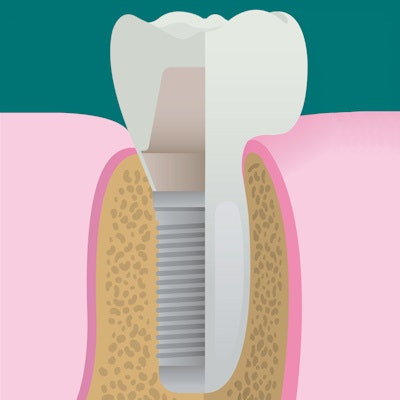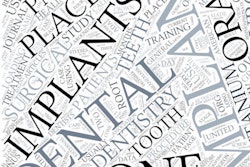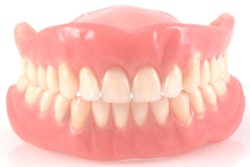
Are patients satisfied with their implant-supported fixed complete dental prostheses? Do complication rates or quality of life vary depending on the type of prosthesis material? And which types of prostheses are more likely to fail? A new study provides some answers.
Researchers studied results in patients who received an implant-supported full-arch prostheses one to five years earlier. They found that complications were common yet patient satisfaction was high, although findings varied by prosthesis type (Journal of Oral Implantology, November 1, 2017).
"What most surprised me was that the number of complications didn't seem to have a huge impact on patient satisfaction," lead study author Virginia Hogsett Box, DMD, told DrBicuspid.com. "My belief is that the difference between one broken tooth and three broken teeth is much less important than how well it was explained to the patient that the prosthesis can break."
Dr. Hogsett Box was an advanced prosthodontic resident at the University of Illinois at Chicago (UIC) College of Dentistry when the research was conducted, but she is now a prosthodontist with ClearChoice Dental Implant Centers in Dallas.
Satisfied patients
Dr. Hogsett Box was motivated to perform the study because, while she usually recommended metal-acrylic prostheses as a good high-end option with known complications, less information was available on results with other prosthesis materials, she told DrBicuspid.com.
"Although metal-acrylic fixed prostheses are a great option, it is well-documented in the literature that broken teeth, fractured gingival acrylic, and pronounced wear all occur commonly," she noted.
Dr. Hogsett Box and colleagues conducted the current study to examine complications associated with various implant-supported full-arch prostheses, as well as patient satisfaction and oral health-related quality of life with the various designs. The study included all patients who received an implant-supported full-arch prosthesis at the UIC Advanced Prosthodontics program between 12 and 70 months earlier.
All prostheses included in the study opposed another implant-supported full-arch prosthesis, natural dentition, or an implant-supported removable prosthesis but not a conventional removable complete denture.
Participants completed the 49-question Oral Health Impact Profile, which measures oral health-related quality of life. They also underwent an interview with a prewritten script of questions and an intraoral exam.
The study included 37 patients with 49 prostheses (25 single arches and 24 double arches). This included 22 metal-acrylic, 14 retrievable crown, seven monolithic zirconia, and six porcelain-veneered zirconia prostheses. None of the patients lost implants or experienced radiographic pathology aside from marginal bone loss.
| Prosthetic complications by material | ||||
| Metal-acrylic (n = 22) |
Retrievable crown (n = 14) |
Monolithic zirconia (n = 7) |
Porcelain-veneered zirconia (n = 6) |
|
| Biologic complications | ||||
| Implant failure | 0 | 0 | 0 | 0 |
| Bone loss > 1/3 implant length | 1 | 3 | 0 | 0 |
| Radiographic pathology | 0 | 0 | 0 | 0 |
| Prosthetic complications | ||||
| Replacement of access plug | 0 | 0 | 1 | 3 |
| Screw loosening | 0 | 0 | 0 | 0 |
| Fractured framework | 0 | 0 | 0 | 0 |
| Marked anterior wear | 1 | 0 | 0 | 1 |
| Marked posterior wear | 10 | 3 | 1 | 2 |
| Fractured teeth | 4 | 6 | 0 | 3 |
| Debonding of gingival material or crowns | 0 | 4 | 0 | 0 |
| Functional complications | ||||
| Aesthetic concerns | 2 | 0 | 0 | 1 |
| Phonetic concerns | 1 | 2 | 0 | 0 |
| Average No. of complications per prosthesis | 0.86 | 1.29 | 0.28 | 1.67 |
Prosthetic problems included four of 13 patients with zirconia prostheses losing a screw access plug (p = 0.01). Overall, six prostheses in three patients were deemed prosthetic failures, two each opposing each other of metal-acrylic, porcelain-veneered zirconia, and retrievable crown, all due to excessive chipping and fracturing of prosthetic teeth. These included both prostheses that experienced marked anterior wear.
The researchers found that posterior wear was the most common complication, followed by chipping and fracturing of teeth. The monolithic zirconia prosthesis with wear was opposing implant-supported single-unit restorations, and the two porcelain-veneered zirconia with wear were opposing each other.
“Patient satisfaction is all about setting proper expectations.”
No monolithic zirconia prosthesis failed for any reason. Overall, monolithic zirconia had the lowest complication rate, and porcelain veneered zirconia had the highest rate. Additionally, no implants failed during the study.
Two patients with metal-acrylic and one with porcelain-veneered zirconia were dissatisfied with the aesthetics of their prostheses, and one patient with a metal-acrylic and two with a retrievable crown felt that their speech had been affected.
Average oral health-related quality-of-life scores indicated that patients had excellent oral health-related quality of life and were satisfied, with no significant differences among the groups. However, those with porcelain-veneered zirconia prostheses had scores indicating lower quality of life, while those with monolithic zirconia had the highest scores.
Some patients expressed in interviews that their implants affected food selection and perceived difficulty of maintaining good oral hygiene. However, most patients were extremely (73%) or very (14%) satisfied with their treatment and thought their prostheses "looked great" (89%).
Bias possible
The authors cautioned that the results were preliminary and noted some study limitations:
- Multiple practitioners provided treatment and may have selected prostheses based on patient characteristics, such as history of bruxism, which could have affected the incidence of complications.
- The researchers did not assess the percentage of patients who wore occlusal guards.
- Sample sizes were small for some of the prosthesis groups.
- It was difficult to differentiate between some complications, such as occlusal wear, and iatrogenic causes, such as occlusal adjustments, because the study was retrospective.
- Prostheses were fabricated by multiple laboratories with varying techniques.
Dr. Hogsett Box emphasized the importance of good communication with patients about outcomes regardless of prosthesis material used.
"Patient satisfaction is all about setting proper expectations," she noted. "If you let the patient know they are likely to have some complications, such as staining, breaks, and wear, they are much more satisfied with the final outcome."



















